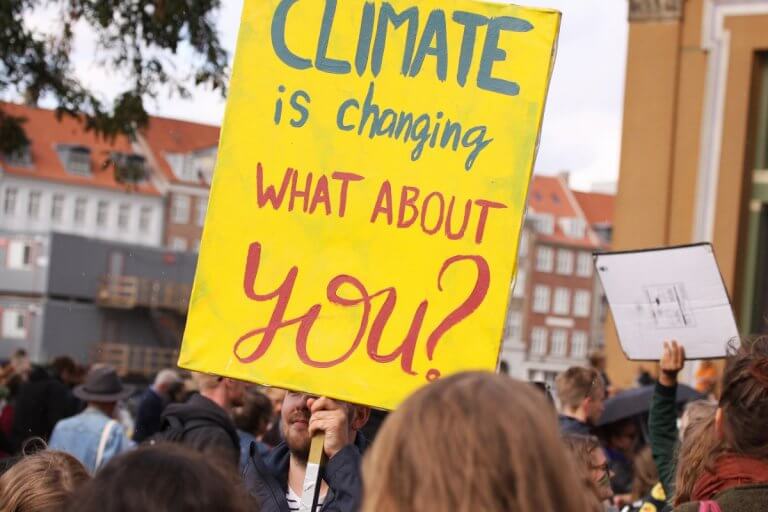
Youth climate strikes are on the rise.
Why?
Because according to the latest Intergovernmental Panel on Climate Change (IPCC) report, “Human activities are estimated to have caused approximately 1.0°C of global warming above pre-industrial levels, with a likely range of 0.8°C to 1.2°C and it is likely to reach 1.5°C between 2030 and 2052 if it continues to increase at the current rate.”
Just one of thousands of hard-hitting reports and articles that highlight the truth about floating trash islands, sea creatures enclosed in suffocating plastics and the destructive threads of fast fashion, it’s no surprise that the youth of today are taking action and trying to protect the natural environment.

Global youth are calling for action. Source: Shutterstock
To educate the current and next generation of leaders on the importance of sustainable consumption and production, it’s essential for education systems to follow and adapt their academic frameworks and campus environments to eco trends.
It’s no simple matter of banning plastic straws from schools, campuses and cafeterias, it’s about innovation, creation and using the power of youth to establish eco-solutions that last a lifetime.
By exposing the truth to young people worldwide, there’s a chance future generations will strive for a greener, cleaner and more sustainable way of life.
To highlight the need for environmental education and eco-friendly schools, I spoke to Johleen Koh, Manager of the FEE EcoCampus Programme and Farisha Zainol, Senior Communications Officer for Education for Sustainable Development (ESD) Programme at WWF-Malaysia.
While discussing the sustainable initiatives the organisation runs within schools and surrounding communities across the country, I soon realised that this team of eco change-makers at their headquarters in Petaling Jaya were way ahead of the curve.
For instance, for 27 years from 1977 to 2004, WWF-Malaysia’s Mobile Education Unit speedily traveled across states to spread environmental awareness. Visiting more than 5,000 schools and more than a million students, their eco efforts started early.
In 2010, the organisation became an associate member of the Foundation for Environmental Education (FEE) and the national operator of the FEE Eco-Schools Programme in Malaysia.
And in 2016, WWF-Malaysia initiated its first ever youth conference on sustainability called Building Bridges for Sustainable Consumption and Production, where delegates took part in community service activities, roundtable discussions, hands-on workshops, talks by industry experts and insightful field trips.

Thousands of Mache Pandas at the ‘1600 Pandas campaign’ by WWF at Publika shopping mall in Malaysia, promoting environmental preservation. Source: Shutterstock
From a flourishing platform for positive youth development programmes and sustainability strategies, perspicacious and worldly students have risen, ready to make real change.
So when I asked the question, “Why is it essential for schools and universities to keep up with eco trends?” Johleen explained that:
“The young people are the future, they are going into society and they are both the producers and the consumers. This is why we bring youth together from all walks of life to our conferences and events, to effectively discuss how we can set sustainable trends in terms of consumption and production.”
Farisha then added that, “Young people make up the biggest population in Malaysia, and a huge chunk of the world, so it’s fundamental that WWF brings in attendees from all over the globe to attend valuable programmes about sustainable consumption and production.”
Likewise, the figures reviewed in last year’s Khazanah Research Institute (KRI) report, titled The School-to-Work Transition of Young Malaysians, also show that the youth age bracket of 18-30 currently make up for the highest demographic in Malaysia (p.14).
So, by welcoming delegates from 18-30 years old to come together and empower others through worthwhile environmental conservation conferences and transformative leadership programmes that train them to protect a deteriorating ecosystem, change is undoubtedly possible.
“We are now calling for delegates for our next conference in Klang (Kuala Lumpur), and the theme will be What is with plastics? It takes place on 1-4 August 2019,” Johleen notes.
Calling all Youth Advocates! We have great activities lined for you. Themed “What’s with Plastics?” the BB4SCP conference promises a fun-filled 4D3N experience on sustainability issues. Register now at https://t.co/GRjXnV8YDT because seats are limited! https://t.co/SHqNGscOQk
— WWF-Malaysia (@WWFMy) February 7, 2019
As we look towards the future, we need to preserve the intrinsic link between environmental and education systems.
They must walk together in harmony, understanding that without each other, both minds and forests are under threat.
Educating the youth of today on key eco trends and the necessity to adopt them is essential, not just because of their vast population size, but as Johleen says, they are our future.
Bringing them together through conferences, projects and school-led events is a move that’s fundamental.
If they are denied an opportunity to express their environmental worries or fears over climate change, they are denied a chance to salvage their future.
So, if we want to keep this planet running, academic institutions need to reduce their ecological footprints and increase their positive environmental impact.
Liked this? Then you’ll love…
The environment is collapsing – can higher education save it?
5 UK universities that are change agents for sustainable agriculture







